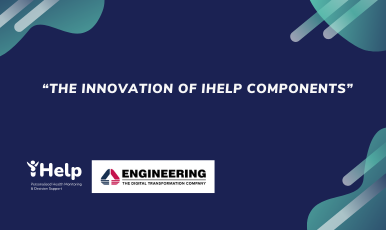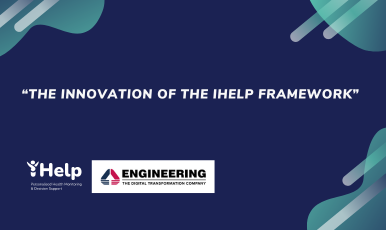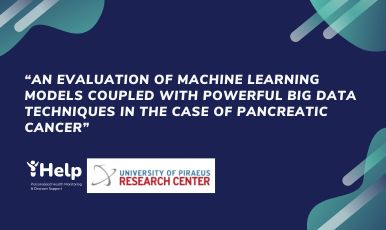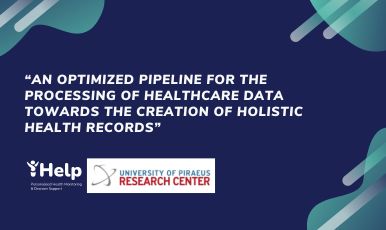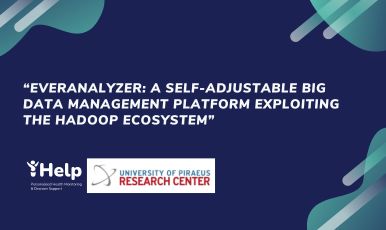Up to 30% of the world’s stored data is currently generated by healthcare systems. However, the healthcare sector is lagging in realizing its potential: it is a “data-rich but information-poor” industry [OEC19]. Taking this into consideration, digital transformation can bring significant benefits to the healthcare sector and, in particular, cancer care is one of the major disease areas that will benefit from the better exploitation of clinical and real-world data using powerful tools such as Artificial Intelligence (‘AI’) and High-Performance Computing to improve e-health, decision support system, telemedicine, remote monitoring system, health data access, and health data exchange.
The iHelp Framework and its components go exactly in this direction, enabling i) the collection, integration, and management of health-related data from various sources (medical records, lifestyle, behaviour data, and social media interactions) in a standardised structure called Holistic Health Records and ii) the analysis of these data using advance AI techniques to draw adaptive learning models iii) that are used to provide decision support, in the form of early risk predictions as well as personalised prevention & intervention measures, delivered through user-centric mobile and wearable applications.
In particular, during the project the Innovation activities identified several innovative components, considered as potential Innovation Items: AI models for Personalised Health Prediction; Analytic Workbench; BigData Platform; Social Media Analyser; Monitoring, Alerting and Feedback; Holistic Health Record; Tailored Conversational Coaching System; Offline Model Learning Service; Advanced Notebook; Bounce Mitigation; Decision Support System (DSS) with visual analytics; Data mapper converter from OMOP (OHDSI) to Holistic Health Records (HHR) (FHIR) and Harmonized and integrated dataset of clinical, real world and behavioural data, including PROMs, for monitoring pancreatic cancer patients undergoing radiotherapy.
An assessment of all the potential Innovation Items, as previously identified, has been constantly conducted, during the project lifetime, by analysing the components under several points of view – the technology innovation trends, the market forecast, the competitive advantage, and the sustainability of the solutions – in order to select the most promising outcomes that can create an added value for both the partners and the healthcare community and reduce the gap between project results and targeted market.
Technology Innovation trends
The potential Innovation Items incorporate the latest trends and cutting-edge technologies in healthcare [WHO24] [WEF23] [WEF24] [FOR24] [GAR24], in particular, the adoption of a more data-driven technologies to help diagnose diseases earlier, the use of Artificial Intelligence in detecting, diagnosing and treating disease, the implementation of Remote Patient Monitoring to ease the access to early disease detection and timely diagnosisand Virtual Healthcare Assistants and chatbots helping clinicians by providing advice on treatments, diagnoses, and medications and patients by answering questions about their care.
Indeed:
- The AI models for personalized Health Prediction belongs to the area of AI technologies;
- The Analytic Workbench, the Big Data Platform, the Holistic Health Record, the Advanced Notebook, the Harmonised and integrated dataset and the OMOP2FHIR Data Mapper belong to the Data and Analytics innovation area;
- the Monitoring, Alerting and Feedback component, the Bounce Mitigation and the Social Media Analyser belong to the Innovation trend called Remote Patient Monitoring;
- the Decision Support System and the Tailored Conversational Coaching System belong to the Virtual Healthcare Assistant innovative trend.

Figure 1: Technological Innovation areas of iHelp potential Innovation Items.
Market forecasts
Within the assessment phase, the potential Innovation Items have been prioritized according to how much promising they were from the point of view of the market exploitation, taking a Gartner Hype Cycle [GAR23b] as a reference point.

Figure 2: Gartner Hype Cycle for Healthcare Providers, 2023.
Then, iHelp potential Innovation Items have been reconducted to the categories of technologies described in the Gartner Report and were ranked according to the market potential, from the most innovative (emerging) to the most mature (mainstream), from the most impactful (transformational) to the less influential (medium), and accordingly with the market penetration. The results are represented in the following table.
Table 1: Ranking of iHelp potential Innovation Items based on Gartner Hype Cycle.
| # | Potential Innovation Items | Gartner categories | Innovation | Impact | Penetration |
| 1 | Monitoring, alerting and feedback component | Personalised Health | Emerging | Transformational | 5-20% |
| Personalized health improves an individual’s health by predicting the likelihood of future illness and recommending actions or interventions to promote health and disease prevention. Personalized health breakthroughs will eventually operationally and technologically disrupt the healthcare ecosystem and organizations’ business models. The shift from curative to preventive care with personalized health interventions will become the new gold standard in medicine. | |||||
| Patient-centered clinical decision support | Emerging | High | 5-20% | ||
| Patient-centered clinical decision support directly engages with the patient or caregiver to deliver evidence-based CDS, focusing on meaningful and achievable personal health goals and outcomes for the individual patient. | |||||
| 2 | Tailored conversational coaching system | Personalised Health | Emerging | Transformational | 5-20% |
| Personalized health improves an individual’s health by predicting the likelihood of future illness and recommending actions or interventions to promote health and disease prevention. Personalized health breakthroughs will eventually operationally and technologically disrupt the healthcare ecosystem and organizations’ business models. The shift from curative to preventive care with personalized health interventions will become the new gold standard in medicine. | |||||
| 3 | Social Media Analyser Bounce Mitigation Integrated and harmonised dataset | Healthcare consumer persuasion analytics | Emerging | High | 5-20% |
| Healthcare consumer persuasion analytics uses consumer, clinical, experiential, engagement, social, environmental and behavioural data to derive and understand needs and preferences, key motivators and influencers of individual health behaviours and outcomes. It combines this insight with advanced analytics technologies and data sciences to identify techniques and tactics to persuade consumers to undertake actions that benefit their individual health | |||||
| 4 | AI models | Algorithmic medicine | Adolescent | Transformational | 5-20% |
| Algorithmic medicine enables advanced clinical decision support using insights and rules built from clinical guidelines, evidence-based best practices, and other clinical data repositories to accurately draw “expert level” diagnosis and treatment decisions. These solutions rely on artificial intelligence (AI), machine learning (ML), natural language processing and rule-based algorithms to augment clinical judgment by suggesting diagnoses and specific treatment protocols. | |||||
| 5 | Decision Support System | Care pathways Orchestration | Adolescent | High | 5-20% |
| Care pathways Orchestration provide a standardized, evidence-based clinical plan for the appropriate sequence of care delivery activities, such as investigations, treatment and education, for a defined patient cohort. Care pathway orchestration employs digital technologies to coordinate care delivery, deliver decision support and automate specific processes across a care journey. They enable healthcare providers to deliver personalized, proactive and coordinated care. | |||||
| 5 | OMOP2FHIR Data Mapper | Semantic interoperability | Adolescent | High | 5-20% |
| Semantic interoperability in healthcare is achieved when two or more information systems can exchange and process business and clinical information with an unambiguous and common understanding. Furthermore, the participating systems need not know how the information will be used before any information exchange. This technology covers the technologies and working groups that support this objective | |||||
| 6 | Holistic Health Records | Enterprise electronic health records (EHRs) | Early mainstream | High | +50% |
| Enterprise electronic health records (EHRs) are clinical systems used in acute and ambulatory (outpatient) care settings. They capture, store, maintain, and share patient centric encounter, treatment, and health status information. The EHR supports tasks directly related to patient care and facilitates clinical documentation, order processing and clinical decision support | |||||
| 7 | BigData Platform Analytic Workbench Advanced Notebook | Advanced analytics architecture | Early mainstream | High | 20-50% |
| Advanced analytics architecture for healthcare providers represents the next-generation approach to derive value from data. Traditional provider analytics architecture typically includes information portals (reports and dashboards) and an analytics workbench (data exploration). Advanced architecture adds data science and machine learning platforms (for advanced modelling), as well as a decision hub (to deploy real-time insight into operations) and coordinates all four functional elements. | |||||
Competitive advantage
All components possess distinct competitive advantages that set them apart from their competitors. However, to safeguard the proprietary exploitation strategies and maintain the strategic edge of each partner, we have chosen not to disclose these specific advantages. This approach ensures that our partners can continue to operate with a high level of confidentiality and security, ultimately preserving the integrity and success of our collective efforts in the marketplace.
Sustainability
The sustainability of the potential Innovation Items was verified through a questionnaire during the final period of the project, to check the commitment of partners to invest in their results after the end of the project to guarantee the maximum impact of the solutions on the society.
The responses to the questionnaire reveal that all partners intend to use the project outcomes to continue investing in research activities, while only some plan to invest in their components for commercial exploitation. In particular, the potential Innovation Items that will be further investigated for a commercial use are the following: the Analytic Workbench, the Big Data Platform, the Social Media Analyser, the Monitoring Alerting and Feedback Component and the Tailored Conversational Coaching System.
Results
The results of the Innovation Assessment analysis, matching all the selection criteria, are that, although all the identified potential Innovation Items appear innovative from a technological standpoint, the Innovation Items with the most promising technological innovation, market trends, competitive advantage and sustainability after the end of the project are the following:
- Monitoring Alerting and Feedback Component (ref. Blog post)
- Tailored Conversational Coaching System (ref. Blog post)
- Social Media Analyser (ref. Blog post)
All the three items belong to three European small and medium Enterprises (KOD is a SME located in Bulgaria; INS is a SME located in Belgium; ICE is a SME located in Spain) and this means they are projected in today’s competitive landscape with innovative and impactful solutions for the healthcare industry and play a critical role in developing a more competitive economy.
Sources
[OEC19] OECD (2019), Health in the 21st Century: Putting Data to Work for Stronger Health Systems, OECD Health Policy Studies, OECD Publishing, Paris
[WHO24] World Health Organization, Digital Health https://www.who.int/health-topics/digital-health#tab=tab_1
[WEF23] World Economic Forum, 5 innovations that are revolutionizing global healthcare, Feb 22, 2023 https://www.weforum.org/agenda/2023/02/health-future-innovation-technology/
[WEF24] World Economic Forum, Resilient, equitable and sustainable: How to deliver healthcare that maximizes the benefits of scientific innovation, Jan 10, 2024 https://www.weforum.org/agenda/2024/01/how-to-deliver-healthcare-that-maximizes-benefits-of-scientific-innovation/
[FOR24] Forbes, The 10 Biggest Trends Revolutionizing Healthcare in 2024, https://www.forbes.com/sites/bernardmarr/2023/10/03/the-10-biggest-trends-revolutionizing-healthcare-in-2024/
[GAR24] Gartner, 2024 Healthcare Provider Business Driver: Health Technology Innovation, 30 January 2024
[GAR23b] Gartner, Hype Cycle for Healthcare Providers, 2023, 17 July 2023

